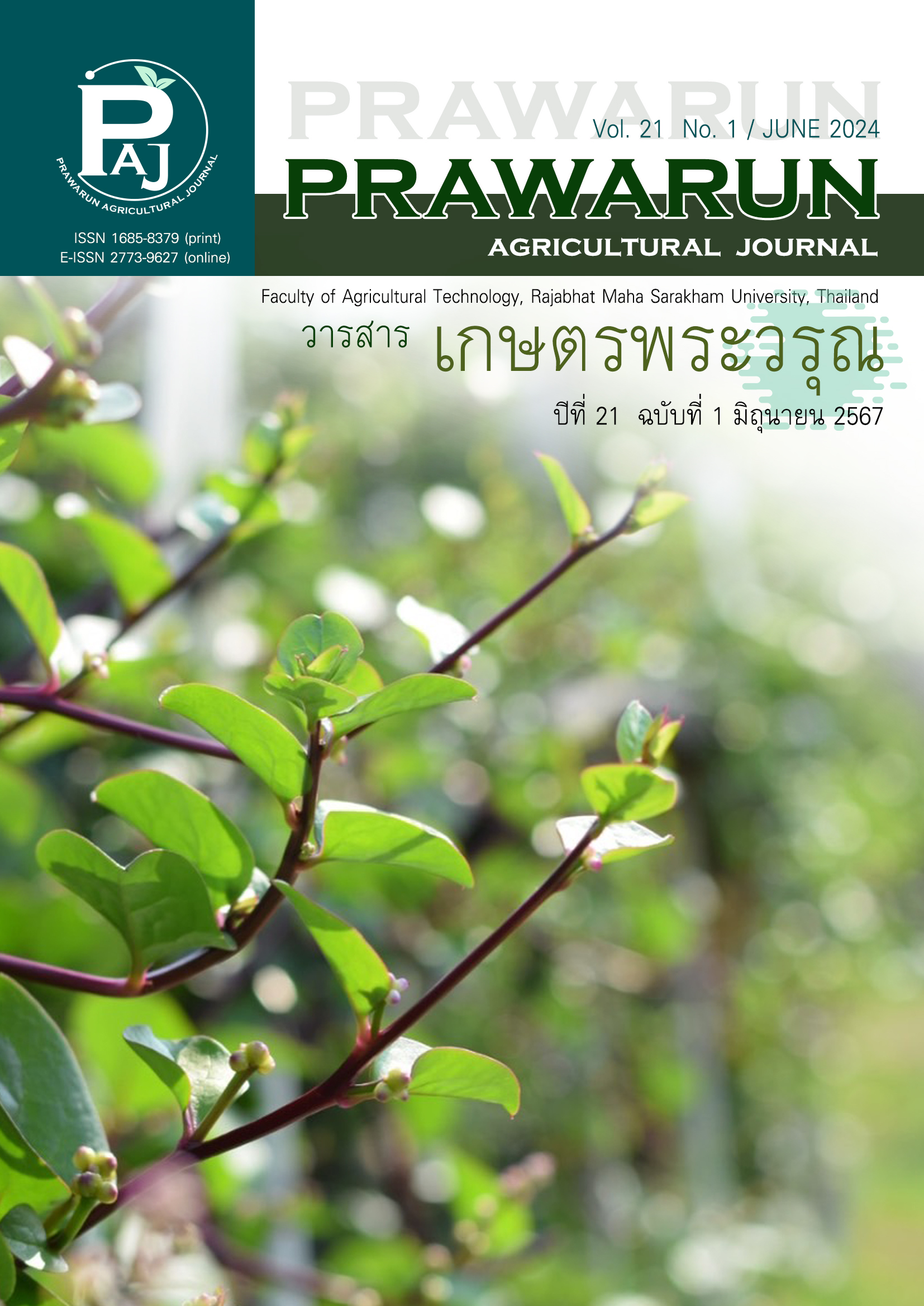การพัฒนาผลิตภัณฑ์มาการองจากกากมะพร้าวเหลือใช้
Main Article Content
บทคัดย่อ
การวิจัยนี้ศึกษาการนำกากมะพร้าวเหลือใช้มาพัฒนามาการอง โดยวิเคราะห์ลักษณะเคมีกายภาพ ประเภทเมอแร็งก์ ผลต่อคุณภาพ คุณค่าโภชนาการ และการยอมรับจากผู้บริโภค พบว่า กากมะพร้าวมีค่าสี L* a* และ b* เท่ากับ 89.77 0.41 และ 9.51 ตามลำดับ และมีค่าความชื้น เถ้า ไขมัน โปรตีน คาร์โบไฮเดรต และเส้นใยอาหารคิดเป็นร้อยละ 4.10 1.21 42.41 4.27 48.01 และ 36.27 ตามลำดับ นอกกจากนี้ยังพบว่าเทคนิคการตีเมอแร็งก์อิตาเลี่ยนมีผลต่อความแข็งแรงของโครงสร้างไข่ขาว จากการประเมินทางด้านประสาทสัมผัสเบื้องต้นแสดงให้เห็นว่า เมอแร็งก์อิตาเลี่ยนได้คะแนนยอมรับสูงกว่าเมอแร็งก์ประเภทอื่น เช่น เฟรนช์และสวิส การเพิ่มกากมะพร้าวในสูตรมาการองทำให้ค่า L* ลดลง ขณะที่ค่า a* และ b* เพิ่มขึ้น โดยไม่ส่งผลต่อค่าความชื้นและค่าวอเตอร์แอคติวิตี้ (aw) เมื่อเทียบกับสูตรควบคุม ส่วนค่าความแข็ง (Hardness) มีค่าสูงขึ้น และค่าความกรอบ (Crispness) ลดลงตามสัดส่วนของกากมะพร้าวที่เพิ่มขึ้น และยังพบการเพิ่มขึ้นของใยอาหารในตัวอย่างมาการองที่มีปริมาณกากมะพร้าวสูงขึ้น การทดสอบการยอมรับของผู้บริโภค พบว่ามาการองที่มีอัตราส่วน 2:1 (อัลมอนด์ป่นต่อกากมะพร้าว) ได้รับการยอมรับโดยไม่แตกต่างจากสูตรควบคุม อย่างไรก็ตาม การเพิ่มสัดส่วนกากมะพร้าวสูงขึ้นมีแนวโน้มทำให้การยอมรับลดลง ดังนั้นการใช้อัลมอนด์ป่นต่อกากมะพร้าวที่อัตราส่วน 2:1 ในการผลิตมาการองเป็นอัตราส่วนที่เหมาะสมที่สุด ซึ่งนอกจากจะเพิ่มคุณค่าทางโภชนาการแล้วยังได้รับการยอมรับจากผู้บริโภคสูงสุด ทำให้การพัฒนามาการองจากกากมะพร้าวเป็นแนวทางใหม่ในการนำวัตถุดิบเหลือใช้กลับมาใช้ประโยชน์อย่างมีคุณภาพ
Article Details
เอกสารอ้างอิง
Adeloye, J. B., Osho, H., & Idris, L. O. (2020). Defatted coconut flour improved the bioactive components, dietary fibre, antioxidant and sensory properties of nixtamalized maize flour. Journal of Agriculture and Food Research, 2(4), 100042. doi: 10.1016/j.jafr.2020.100042
Association of Official Analytical Chemists (AOAC). (2016). Official methods of analysis. (20thed.). Washington D.C., United States: Association of Analytical Chemists.
Boonna, P., Manarote, A., Panyathitipong, W., & Masavang, S. (2022). Effect of sugar content on physical and sensory properties of tapioca-based cookies. Journal of Applied Research on Science and Technology (JARST), 21(2), 14-25. (in Thai) doi: 10.14456/jarst.2022.14
Boonsiriwit, A., & Sriwarom, N. (2018). Processing of egg white pastries (macaroon) by using peanut and cashew nut powder as almond powder replacement. Dusit Thani College Journal, 12(2), 182–192. (in Thai)
Chinnasarn, S., & Chinnasarn, K. (2015). Extraction and utilization of dietary fiber and cellulose from coconut residue for value creation of agricultural by-products and mass transfer prediction models during frying process (Research report). Chonburi, Thailand: Burapha University. (in Thai)
Chiralaksanakul, N. (2018). Effects of mixing time before baking, egg white aging, reduction of sugar and icing sugar content on the quality of macaron shells (Master’s thesis). Bangkok, Thailand: King Mongkut's Institute of Technology Ladkrabang. (in Thai)
Chomchom, N., Uppathak, C. & Sakunyuenyongsuk, N. (2013). Development of Thai dessert product from used coconut residue (Research report). Bangkok, Thailand: Rajamangala University of Technology Phra Nakhon. (in Thai)
Department of Agriculture. (2020). Coconut production situation. Accessed May 6, 2022. Retrieved from https://www.doa.go.th. (in Thai)
Eadmusik, S., Phungamngoen, C., Panphut, W., & Budsabun, T. (2022). Partially substitution of wheat flour by coconut residues in bakery products and their physical and sensorial properties. Food Research, 6(1), 99-105. doi: 10.26656/fr.2017.6(1).140
Marikkar, J. M. N., & Madurapperuma, W. S. (2012). Coconut. In M. Siddiq (Ed.) Tropical and subtropical fruits: Postharvest physiology, processing and packaging (pp. 159-177). Iowa, USA: John Wiley & Sons. doi: 10.1002/9781118324097.ch9
Panyayong, C., & Khantasen, V. (2018). Development of almond powder substitute macaron form cashew nut powder. Srinakharinwirot University (Journal of Science and Technology), 10(19), 14-30. (in Thai)
Pedcharat, K., Sae-Tang, D., & Tungsatitporn, D. (2014). Development of food products from used coconut residue. (Research Report). Bangkok, Thailand: Rajamangala University of Technology Phra Nakhon. (in Thai)
Portugal, T. R., Parcon, M. R. V., & Udarbe, M. A. (2013). Proficiency test on total dietary fiber in wheat flour. International Journal of Chemical Engineering and Applications, 4(2), 82-87.
Quan, T. H., & Benjakul, S. (2019). Duck egg albumen: physicochemical and functional properties as affected by storage and processing. Journal of Food Science and Technology, 56(3), 1104-1115.
doi: 10.1007/s13197-019-03669-x
Raiva, P. (2016). Thai bakery industry. Accessed July 20, 2022. Retrieved from http://fic.nfi.or.th/foodindustry_ceo_view.php?smid=1126. (in Thai)
Reitz, N. F. (2016). Investigating the chemical basis of functionality differences between beet and cane sugar sources in model egg white foams and other products (Master’s thesis). Illinois, United States: University of Illinois at Urbana-Champaign.
Siyunglek, M., Techakriengkrai, T., & Siriwong, N. (2020). Preparation and application of dried almond residue for substitution of almond flour in macaron. Thai Science and Technology Journal, 28(9), 1572-1584. (in Thai) doi: 10.14456/tstj.2020.125
Sykut-Domańska, E., Zarzycki, P., Sobota, A., Teterycz, D., Wirkijowska, A., Blicharz-Kania, A., Andrejko, D., & Mazurkiewicz, J. (2020). The potential use of by-products from coconut industry for production of pasta. Journal of Food Processing and Preservation, 44(7), e14490. doi: 10.1111/jfpp.14490
Thai Industrial Standards Institute. (2005). Thai community product standard of Khanom Ping. TCPS no. 745/2548. Bangkok, Thailand: Thai Industrial Standards Institute. (in Thai)
Thinkarn, K. (2019). Coconut meal clay development for craft products (Master’s thesis). Pathum Thani, Thailand: Rajamangala University of Technology Thanyaburi. (in Thai)
Trinidad, T. P., Mallillin, A. C., Valdez, D. H., Loyola, A. S., Askali-Mercado, F. C., Castillo, J. C., Encabo,
R. R., Masa, D. B., Maglaya, A. S., & Chua, M. T. (2006). Dietary fiber from coconut flour: a functional food. Innovative Food Science & Emerging Technologies, 7(4), 309-317.
doi: 10.1016/j.ifset.2004.04.003
Wirkijowska, A., Sobota, A., Zarzycki, P., Nawrocka, A., Blicharz-Kania, A., & Andrejko, D. (2021). Chemical, technological, and sensory evaluation of the suitability of coconut by-products in white rolls. Journal of the Science of Food and Agriculture, 102(8), 3370-3378.
doi: 10.1002/jsfa.11684
Yalegama, L. L. W. C., Karunaratne, D. N., Sivakanesan, R., & Jayasekara, C. (2013). Chemical and functional properties of fibre concentrates obtained from by-products of coconut kernel. Food Chemistry, 141(1), 124-130. doi: 10.1016/j.foodchem.2013.02.118
Yang, X., & Foegeding, E. A. (2010). Effects of sucrose on egg white protein and whey protein isolate foams: factors determining properties of wet and dry foams (cakes). Food Hydrocolloids, 24(2-3), 227-238. doi: 10.1016/j.foodhyd.2009.09.011


